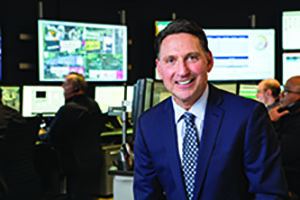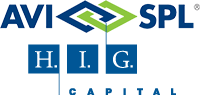One BILLION dollars. It’s a revenue level few ever expected we’d see in the AV industry, but it’s coming faster than you might realize, with a couple of companies poised to earn the honors as the first $1 billion systems integrator.
That elusive—and exclusive—revenue level is becoming a reality now thanks to major acquisitions and an infusion of piles of cash from private equity firms and venture capitalists over the past couple of years. [related]
Even those integrators that still have a way to go before reaching the 10-figure mark have solidified their spots at the top of the systems integrator food chain, with one joining the conversation this year thanks to—what else?—a major acquisition, and another building primarily organically and strategically.
This year, rather than singling out one integration firm to join the Integrator of the Year Club, we award the honor to that mythical leviathan we’ve dubbed The Mega-Integrator.
Let’s take a closer look at how the Mega-Integrator became Integrator of the Year by impacting the AV industry, one-upping the competition, and meeting its customers’ needs more effectively.
The Mega-Integrator Club
AVI-SPL has long been the AV industry standard, earning CI’s first Integrator of the Year nod in our initial year in publication, 2011, and closing out 2017 with revenue in the $725 million range.
Diversified, former Integrator of the Year, has made several major acquisitions in the past couple of years and seems to be closing fast on AVI-SPL as the space’s top money-earner at about $650 million.
What’s interesting is AVI-SPL CEO John Zettel seems to embrace the idea of his company reaching the billion-dollar mark, saying it’s part of the company’s plan for the next three to five years, while Diversified chairman and CEO Fred D’Alessandro continues to focus on the company he started in 1993 being the best in the AV industry, whether it’s the biggest, second-biggest or 100th-biggest.
“Our growth strategy is predicated on customer demand,” says Zettel. “What’s changed dramatically is what we can offer our customers.”
Through unified communications, managed services and geographic expansion around the world thanks to capital investment by H.I.G. Capital, AVI-SPL has placed “an extreme value on consistency,” says Zettel.
“Our size represents the experience we have and what we do every day,” he says, noting AVI-SPL works on about 6,000 projects every year. “That absolutely lends credibility to our customers. Our size has also allowed us to expand our platform for our customers with design, integration and managed services.
“The dollar amount of revenue isn’t the story. It’s what it took to get there,” says Zettel, who’s been with the company for 17 years and been involved in mergers and acquisitions for most of that time, including most notably when AVI and SPL merged in 2008 to forge somewhat of a mega-integrator in the first place so to speak.
Former Integrator of the Year AVI-SPL’s recent activity also earned it a spot on the “Fast Growing Integration Firms” list.
“We adopted M&A as a strategy long before it became popular in our industry,” Zettel continues.
“The board has been very agreeable to our growth strategy. We’re seeing a form of stratification where companies are being more accepting of being acquired.”
Under D’Alessandro, Diversified made a few acquisitions through 2015, which he called “a good way to learn the process,” but the primary focus was reinvesting the profits into the company and its employees, including one division with $10 million in reinvestment.
“Our customers always had a lot of respect for Diversified,” says D’Alessandro. “We were always the go-to guys for the challenging projects with tight deadlines.” Eventually, company leadership decided they needed to find outside investors to help them deliver the full-scale solutions their customers wanted.
“We needed more capital to move the needle,” says D’Alessandro. “It would’ve been easy for us to go to $250 million, but the demand was for more than that. We had to find a way to quickly fulfill the needs of our customers. It’s something I saw coming about three or four years earlier [before Tailwind Capital invested in Diversified].”
That led Diversified to acquire Technical Innovation (TI) in February 2016, The Systems Group the next month, Media Management in November 2016, CompView in June 2017 and MCW in October.
It’s pushed the company from about $220 million in revenue to a projected $650 million in less than two years. The flurry of deals represents an effort to allow Diversified to deliver “what customers expect from us.”
TI, for example, added AV and mission-critical capabilities to a company that was primarily known for its expertise in the broadcast space, while The Systems Group bolstered its media capabilities and MCW was about managed services in the security space.

Diversified, another former Integrator of the Year, also earned a spot in the inaugural “Fast Growing Firms.”
The other deals gave Diversified stronger presences in new markets.
“It’s been about delivering more solutions to more customers,” says D’Alessandro, who’s gone from the top salesman at Diversified two years ago to not selling at all today.
“I expect us to deliver the best solutions. A lot of responsibility comes with that.”
Other Systems Integrator Contenders Ramp Up
While former Integrator of the Year winners AVI-SPL and Diversified seem to be the most likely integrators to first crack the billion-dollar revenue milestone, there are other companies that have hit the accelerator in recent years.
That means expanding their business around the world (like Whitlock) or securing a long-awaited final piece of the puzzle (like Carousel Industries acquiring fellow IT systems integrator Atrion in 2016).
AVI-SPL and Diversified have used strategic acquisitions to boost their bottom lines and help their companies move closer to the billion-dollar revenue level, while Whitlock has approached its growth a little differently over the years.
Earlier this year, Whitlock executive VP Julian Phillips told CI editor Tom LeBlanc, “we’re going to acquire AVI-SPL… one customer at a time. That’s basically our acquisition strategy.” Carousel Industries CEO Jeff Gardner told CI the addition of Atrion was a natural fit.

Diversified, CI’s 2016 Integrator of the Year, has launched a business consulting program. © Matt Greenslade/photo-nyc.com
“The more we talked about both business and what we each bring, the more excited I got about the prospect of bringing the two companies together,” says Gardner.
“I can see this move help both companies reduce the number of vendors and simplify operations for both of us.”
Meanwhile, Convergint Technologies represents the greatest threat to reach $1 billion in the commercial integration industry’s adjacent life-safety and security space, with more than 2,000 employees and a penchant for strategic acquisitions.
“Convergint’s meteoric growth and success is no accident. In a relatively short period of time, it has become of one of the most successful and reputable companies in our industry,” Bill Keller, president of SigNet Technologies, said after his company was scooped up by Convergint in July.
The Systems Integrator Headed for $1 Billion
Zettel isn’t surprised to see AVI-SPL nearing $1 billion in revenue, but he doesn’t want it to be a hollow achievement.
“We talk a lot about what it would mean to us as a company,” he says.
“It’s driven by what our company would look like if we get there. It’s a little bit of a longer-term goal, maybe three to five years.”
Having a company hit the $1 billion revenue mark “brings credibility to our industry, which has mainly existed on a local or regional basis.
“This is proof there’s a national and global model that can succeed on a scalable, consistent basis. Where we are today is a reflection of the hard work all of us have put in,” says Zettel.
The push toward $1 billion “is happening for us because we’re able to provide more solutions to our customers than we did before,” says D’Alessandro.“If we could deliver a $2 million solution a couple of years ago, now we can deliver a $10 million solution.
“Multiply that out by the number of customers we work with and it’s a lot of revenue.
“We’re dealing with a lot of global organizations who have quick turnarounds so it can get pretty intense. We built a strong team of project managers and engineers and we certainly wouldn’t have seen as much incremental business as we’re seeing today without that,” he says.
“You can’t be a billion-dollar systems integrator and just sell AV or broadcast,” says D’Alessandro.
“If we just hit [$1 billion in revenue] and we’re second or third on winning the projects we want to do, that wouldn’t make me happy. The strategy is to have our solutions and innovate to meet the needs of our customers. We need to work with customers who value what we offer. We’re looking for partnership, not just a vendor-client relationship. If we make our clients successful, we grow together.”
How the AV Industry Got Here
[Editor’s note: Quotes that originally appeared in this section have been deleted. The DAK Group’s business relationship with Diversified, which CI should have disclosed, at the very least, diminishes the objectivity that we strive for in this report.]
Ari Fuchs, director of The DAK Group, which is an investment banking firm specializing in the middle-market, says the combination of $1 trillion in corporate cash “looking for investment opportunities,” low interest rates and motivated buyers and sellers has driven the eye-popping recent growth in the AV industry.
“In addition to the rapid change in technology, this is an industry where there are a lot of integrators who don’t have IT expertise,” says Fuchs.
“In a lot of ways, they’re less sophisticated and can’t compete for some of that more complex business. It’s difficult for a lot of them to move beyond the so-called ‘hangs-and-bangs.’
“AV over IP requires a substantial upgrade in experience. You need to have both AV and IT to be a true success,” says Fuchs.
NSCA executive director Chuck Wilson sees divergent paths, with so-called mega-integrators going down one road and the small integrators “whose sweet spot is projects the mega-integrators ignore” taking the other road.
Verne Harnish, author of “Scaling Up,” will address this topic at the 2018 NSCA Business and Leadership Conference.
“We’ve got a David and Goliath story, with a whole lot of Davids and a few Goliaths,” says Wilson. “What’s the landscape going to look like three years from now? I don’t see it slowing down at all.”
Outside investments in the integration space “makes sense,” says Wilson. “They’ve seen success in our industry.” Also playing a role is the increased importance of AV over IP, intelligent building and building automation, he says
“The more our stuff touches the network, the more appeal we’ll have with the investment community. We’re now a source of profitability for them,” he says.
Integrator of the Year ‘Pick’ a Sign of AV Industry Health?
Sean Wargo, senior director of market intelligence for the Audiovisual and Integrated Experience Association (AVIXA), says the trend toward mega-integrators “highlights a strong message of health for the AV industry.”
There’s a natural business cycle that takes a company from small to growing to one that needs help to grow even larger, he says.
“More and more big corporations are going global and they’re seeking companies to help them with their buildouts,” says Wargo.
Related: From AVI-SPL to Mega-Integrator: All Commercial Integrator’s Integrator of the Year Covers
“That requires capital or partnering or an M&A.” The active systems integrator market is “very cyclical” and something that’s “probably been brewing for a couple of years.”
Wilson sees outside capital as one driver for the breakneck pace of growth, with trouble finding more talented people as another and the third being the ability to create a national and global delivery system.
Talent acquisition “has become such a frustrating thing,” says Wilson. “People are looking now to acquire the people they need through M&A.” As for expanding footprints, “companies believe if they don’t do that, they’ll be eliminated from the pre-qualified list for a lot of clients.”
Wargo isn’t surprised venture capitalists are involved, but doesn’t expect them to stay involved in the space for too long.
“Venture capitalists sniff our opportunities, jump on them and move on,” he says.
“There’s a quick entry and a quick exit. It’s usually a three-to five-year window and they’re looking for a 5x multiple on their investments. They make a living out of identifying areas for investment, with the appropriate levels of due diligence and a planned exit strategy.
“It’s a great PR moment for our industry and it tells you there’s something here. The AV industry is in the early stage of adapting to venture capitalists coming in and now we’re awake to the opportunity and it tells you there are strong opportunities for investment here,” says Wargo.
AV systems integration has become more appealing to outside investors—who are looking to add scale, return on investment and profit—because of the growth of Internet of Things, connectivity and a distributed workforce, says Wargo.
“We’re blurring the lines between AV and IT and there’s more complexity to the solution today,” he says. “Those kinds of things provide opportunities to create massive growth.”
The Changing Landscape of the AV Industry
Fuchs clarifies there’s a difference between a company with $1 billion in annual revenue and one that’s actually worth $1 billion, noting “that’s a function of profitability.”
“We have a ways to go until we see one that’s worth $1 billion,” says Fuchs, adding he expects to see a systems integrator hit the billion-dollar revenue mark as soon as 2019.
The AV industry is one where the average owner is about 50 years old, which also creates some opportunities for mergers, acquisitions or partnerships, he says.
Fuchs advises his clients to “run their companies like you’ll own it forever, but be ready to sell tomorrow.”
“The disappointing thing” about the industry’s growth, says Wilson, is “it’s pushing the price out of reach for the next generation of owners.
Family succession continues to be a strong feature in the AV industry, with HB Communications and Verrex among the most prominent family-owned companies in the space.
“It’s important for these family-owned companies to continue to see opportunities to build and create value,” says Fuchs. “At the same time, a lot of them are looking for a partner that can help them juice the growth of the business.”
The continued desire for the apocryphal “one throat to choke” is also a driving force among integrators to ensure their organizations are as complete as possible, whether that means covering all geographies or having expertise in a variety of vertical markets, says Fuchs.
“There’s a preference among customers to have single-source systems integrator providers,” he says.
“That’s created an opportunity for companies with unique expertise in certain verticals. The AV industry is big enough that there’s always some price competition, but it’s a more pleasant experience for the customer when they’re dealing with a single source provider.
“The integration sector has evolved and the refresh cycles have shortened. That creates substantial opportunity. The competition is fierce. When a systems integrator pitches on a large project, that creates a great amount of visibility but it also comes with a fair amount of risk. Large integrators are built to handle that risk,” says Fuchs.
Zettel believes the advent of so-called mega-integrators “is a benefit to our employees and to our customers.”
He’s not sure how much longer the flurry of acquisitions will last, saying many companies are for sale or considering going up for sale but “the questions is whether the buyers run out.”
AVI-SPL is still actively looking for acquisitions that make sense and fit their philosophy, says Zettel.
Looking ahead to 2020, Wilson sees the AV industry continuing to evolve.
“Looking at the systems integrator ecosystem, we’ll have an integration, design/build and managed services company within the same building,” he says.
“It’s all dictated by the client. It’s one thing to be good at technology, but it’s far more difficult to be profitable.
“This is our new reality. There has to be some point where they hit peak performance and no longer see that open footprint that needs to be filled based on client demand. Bigger can be better, but it isn’t always. If you just acquire and keep spending your operating capital, you’re not able to invest in your existing employees.
“Culture is everything. You have to get that instilled before setting your sights on a new investment,” says Wilson.
Why AV Remains Attractive
The advent of private equity firms investing in systems integrator firms—both AVI-SPL and Diversified are owned by investment companies—has been about three to five years in the making, says Fuchs.
That’s led to a “new growth profile” because the fragmented nature of the AV industry means there’s a chance for private equity companies to “roll up systems integrator businesses into bigger businesses.”
From low-voltage contractors to IT services to mechanical expertise, venture capitalists buyers “are taking notice” of the systems integration ecosystem, says Fuchs.
“It’s somewhat of a herd mentality right now,” he says. “Everyone is thinking about doing something, whether that’s adding a new geography, adding another vertical or increasing in size.”
The Mega-Integrator was a natural byproduct of the evolution of the AV integration space, says Fuchs.
“Integrators need to innovate their service and project offerings. Unless you’re ahead of the curve, it’s more challenging to compete,” he says.
Fuchs sees no end in sight to the flurry of activity in the fractured AV integration market, saying he expects it to be a hive of activity well into 2018. He sees more private equity firms building platforms and adding on to their existing capabilities while more integrators will be acquiring their counterparts.
Read next: Who Would Buy Your AV Integration Business?
“The window is certainly open right now,” says Fuchs. “We’ll definitely see more activity in 2018 and into 2019, but there’s some cyclicality to this so it’s tough to tell beyond that. The foundation is there and the interest is there too.”
D’Alessandro agrees that consolidation will continue in the AV integration world for a while.
“If large integrators can perform at the same level they did when they were smaller companies, that puts a lot of pressure on small integrators,” he says. “There always will be and should be competition,and that forces us to also be better.
“We love the customers that have small projects. That’s how this company was built,” adds D’Alessandro. “Those little projects and little companies turn into big projects and big companies.”








































